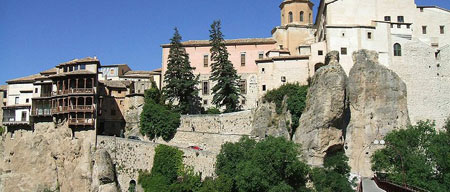Home > Study in Spain > City Guide > Cuenca
Cuenca City Guide
- Places of Interest
- Maps
- Getting to
- Getting around the city
Cuenca is a city in the autonomous community of Castilla-La Mancha in central Spain and is the capital of the province of Cuenca which is one of the largest provinces in Spain with a size close in comparison to that of countries such as Slovenia or Montenegro. The city is divided into two separate settlements: the "new" city is south-west to the old one, which is divided by the Huécar course.
Here, the climate is typically continental Mediterranean with that of relatively cold winters, and intensely hot summers. Cuenca was once an agricultural and textile manufacturing city and has lived through an extensive history such as the Moorish reign, the independence war against Napoleon's troops and a rapidly declining industry, however today the city boasts a wealth of cultural elements, beautiful walkways, a number of spectacular churches and the remains of an ancient Arab fortress.
There are also some beautiful parks which are ideal for a stroll during the warm summer-days or even the romantic winter nights. As the third least populated region in Europe, the town itself is a world heritage site and the old town is an outstanding example of a medieval city. Being built on the steep sides of a mountain, Cuenca is a hidden gem and is ideal for those looking to break away from the hustle and bustle of the larger, more modern, cities of Spain.
Places of Interest
Basílica de Nuestra Señora de Gracia
This is Cuenca's Cathedral and construction began towards the end of the 12th century and was completed in the second half of the 15th century. This magnificent beauty takes on a Gothic style and unlike many other cathedrals in Spain, photography is not normally allowed in the interior.
Las Casas Colgadas
Built over a rock above the Huecar's river Gorge in the 15th century, these are the only remaining sample of this type of building which was frequent in the city a long time ago. Las Casas Colgadas are considered to be the most famous civil buildings in Cuenca and house a restaurant and the Museum of Abstract Arts. The can also be seen from the incredible view from the bridge of San Pablo.
Monument devoted to the Holy Heart of Jesus
Located on the top of the Cerro del Socorro can be found this immense monument devoted to the Holy Heart of Jesus whose materials were transported on donkeys during the mid-20th century. This monument is a break taking viewpoint over the whole city of Cuenca and can be accessed by taking the road to Palomera.
El Parque de San Julían
This is the oldest park in Cuenca and was created at the beginning of the 20th century from land donated by Gregoria Fernández de la Cuba. There is a sculpture dedicated to her here in the park. This park is an example of sustainable design as there is no grass, only rectangles of terrain containing large trees, bush rows and sand paths.
Mangana Tower
Origins of the tower remain unclear however in 1565 it was painted by Antoon van den Wijngaerde which suggests that at that time the Mangana had already been built. After several attacks during the Spanish war of Independence and being hit by a thunderbolt in the 18th century, it became badly destroyed. The tower was then rebuilt in Neomudejar style with Arab influences in 1926. The tower can be reached on foot from the Plaza Mayor and is worth a visit if only for the history it holds.
El Castillo
This is the affectionate name for the ancient Arab fortress representing the older structures of Cuenca. Containing no more than a tower, two stone blocks, the arch which allows to enter/leave the old town from the Barrio del Castillo and a fragment of the walls, this castle was home to the Holy Inquisition after the end of the 16th century and was finally destroyed during the 19th century by French soldiers during the Spanish War of Independence. This is an important part of the city's history and an incredible sight for all.
Museums
Museo Arqueológico
This museum is also a museum of the history of Cuenca and provides a fascinating insight to the archaeology of the city. The museum contains a number of archaeological finds from all over the Cuenca province and contains things such as pieces of ceramic, prehistoric tools, statues, and money from the Roman cities of Segóbriga, Valeria y Ercávia. If you are looking to learn more about this authentic city, this would be a great place to do so, and even moreso with the fact that entry is free at the weekends!
Museo de Arte Abstracto Español
Located in Las Casas Colgadas, this is one of the greatest attractions in the city. In 1966, the artist Fernando Zóbel placed his best pieces of abstract art here. In the museum can also be found works from other great artists from the Spanish Abstract Movement such as Torner, Saura and Rueda. Entry is only 3€ however it is half price for over 65s and students so this is definitely a worthwhile visit.
Maps
Getting to Cuenca
By Air
Cuenca does not have its own airport but Valencia and Madrid are close by and their airports can easily be reached by bus or train from Cuenca.
By Bus
In Cuenca there is a bus station in the city centre which has links to nearby cities. Travel to Madrid and Valencia is also about 2 hours with tickets costing only 12€. This is another option when arriving into Madrid or Valencia airport and hugely facilitates access to the town or even allows for day trips elsewhere.
By Train
There are at least four trains from Madrid and Valencia daily and the journey takes about 2½ hours from Madrid and 3½ hours from Valencia. This year there are also plans for a new high speed train which takes only 45 minutes from Madrid so this will shorten the journey a significant amount.
Getting around the city
Cuenca is a beautiful city and it is easy to walk around the city and admire it on foot. You can hire a car if you want, but walking is probably the best way. The historic city centre is a fairly attainable size so by foot you are able to fully appreciate it and take in the magnificent beauty of its sights and cultural elements.

